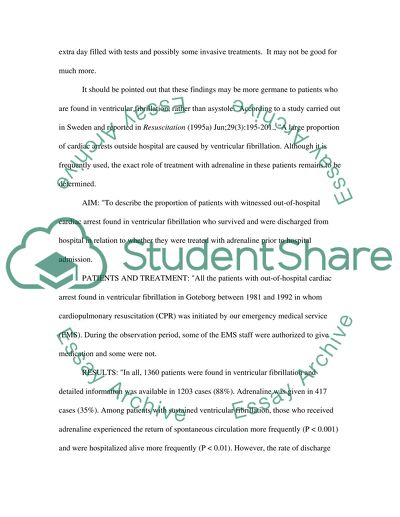Cite this document
(Adrenaline in Cardiac Arrest Coursework Example | Topics and Well Written Essays - 1500 words, n.d.)
Adrenaline in Cardiac Arrest Coursework Example | Topics and Well Written Essays - 1500 words. https://studentshare.org/medical-science/1535042-discuss-the-evidence-or-lack-of-evidence-that-exists-to-support-the-use-of-adrenaline-epinephrine-in-cardiac-arrest-in-pre-hospital-setting-ambulance-work
Adrenaline in Cardiac Arrest Coursework Example | Topics and Well Written Essays - 1500 words. https://studentshare.org/medical-science/1535042-discuss-the-evidence-or-lack-of-evidence-that-exists-to-support-the-use-of-adrenaline-epinephrine-in-cardiac-arrest-in-pre-hospital-setting-ambulance-work
(Adrenaline in Cardiac Arrest Coursework Example | Topics and Well Written Essays - 1500 Words)
Adrenaline in Cardiac Arrest Coursework Example | Topics and Well Written Essays - 1500 Words. https://studentshare.org/medical-science/1535042-discuss-the-evidence-or-lack-of-evidence-that-exists-to-support-the-use-of-adrenaline-epinephrine-in-cardiac-arrest-in-pre-hospital-setting-ambulance-work.
Adrenaline in Cardiac Arrest Coursework Example | Topics and Well Written Essays - 1500 Words. https://studentshare.org/medical-science/1535042-discuss-the-evidence-or-lack-of-evidence-that-exists-to-support-the-use-of-adrenaline-epinephrine-in-cardiac-arrest-in-pre-hospital-setting-ambulance-work.
“Adrenaline in Cardiac Arrest Coursework Example | Topics and Well Written Essays - 1500 Words”. https://studentshare.org/medical-science/1535042-discuss-the-evidence-or-lack-of-evidence-that-exists-to-support-the-use-of-adrenaline-epinephrine-in-cardiac-arrest-in-pre-hospital-setting-ambulance-work.


